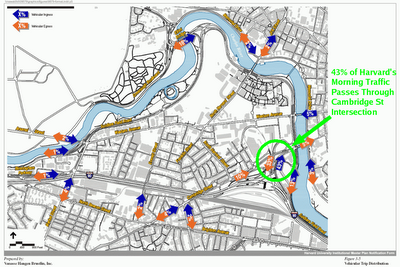I present the following hypothesis: the success or failure of Harvard's traffic plan for Allston will hinge on how they deal with the intersection where Cambridge Street reaches the Charles River (IMPNF, Figure 3-5, annotated):

Harvard's own numbers, estimated using a model constructed in collaboration with the Boston Transportation Department, shows that 43% of their morning automobile traffic will exit the Mass Pike's A-B tolls and enter this intersection. (IMPNF, Table 3-5)
Q: How many cars will this be at the end of their 20-year master plan?
A: 8,145 * 0.43 [morning] + 7,775 * 0.33 [evening] = 6,068 cars per day (IMPNF, Table 3-4; IMPNF, Figure 3-5)
Q: How many cars currently pass through that intersection daily?
A: 28,464 (HUAM PNF, Table 3-1)
Q: What percentage increase in traffic will Harvard's Allston development cause on this intersection?
A: 6,068 / 28,464 = 21%
That intersection is already far, far too crowded. No, it suffers from gridlock. Until Harvard and/or the City fix the intersection, nothing else will really matter.
No comments:
Post a Comment